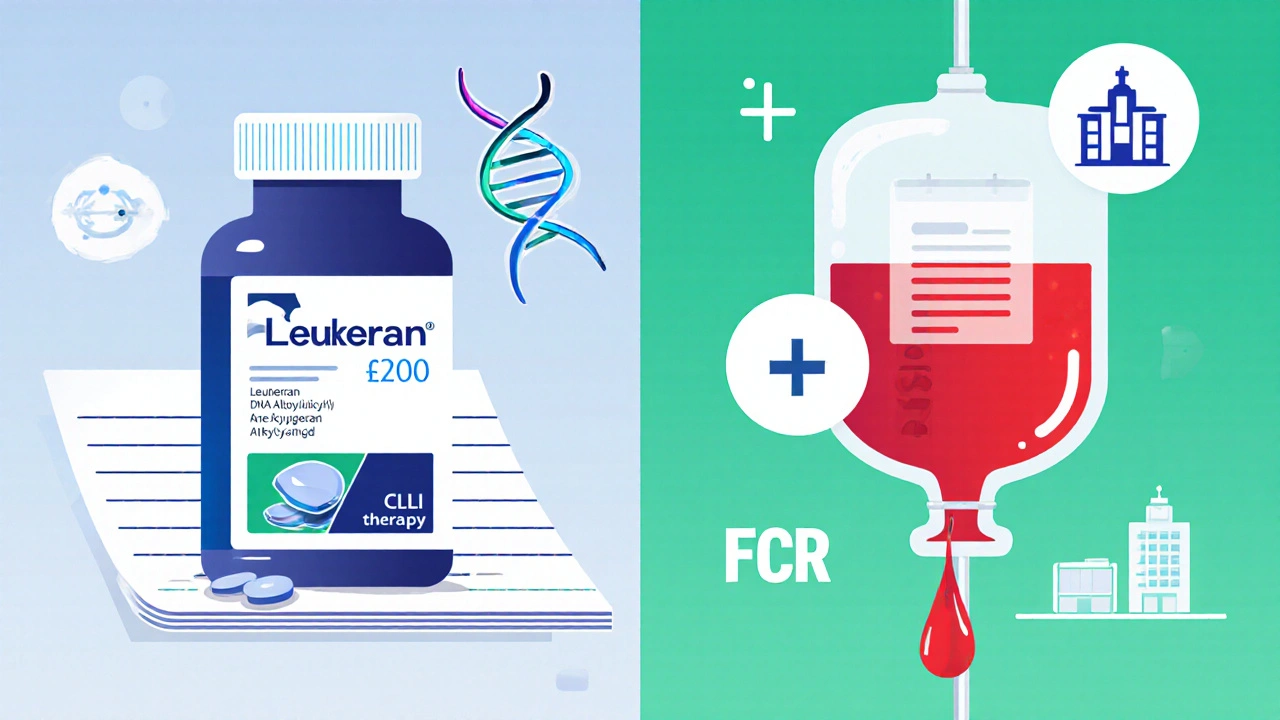CLL Treatment Comparison Tool
Your Situation
Treatment Options
When you or a loved one faces chronic lymphocytic leukaemia (CLL), the flood of drug names can feel overwhelming. Leukeran (the brand name for chloralkylating agent chlorambucil) has been a backbone of oral CLL therapy for decades, but newer agents promise higher response rates and different side‑effect profiles. This guide breaks down what Leukeran does, how it stacks up against the most common alternatives, and which factors matter most when you discuss options with a clinician.
Quick Takeaways
- Leukeran is an oral alkylating agent approved for CLL and low‑grade lymphoma; its response rate hovers around 30‑40%.
- Newer targeted oral drugs (e.g., ibrutinib, venetoclax) achieve 70‑90% overall response but may cost 15‑30 times more.
- Older chemotherapy combos (cyclophosphamide, fludarabine, bendamustine) are given IV and can cause higher short‑term toxicity.
- Choosing a therapy hinges on disease stage, patient age, comorbidities, and personal priorities (pill vs. infusion, cost, side‑effects).
What is Leukeran (Chlorambucil)?
Leukeran is the trade name for chlorambucil, an alkylating chemotherapy agent that works by adding a chlorine‑bearing group to DNA, disrupting replication in rapidly dividing lymphocytes. It was first approved in the United Kingdom in 1958 and remains the only oral agent widely reimbursed by the NHS for front‑line CLL in patients over 65 or with significant comorbidities.
Typical dosing starts at 0.5mg/kg per day for 14days, repeated every 28days, though many clinicians now use a low‑dose continuous schedule (e.g., 0.1mg/kg daily) to improve tolerability. The drug is metabolised in the liver and excreted by the kidneys; dose adjustments are needed for impaired renal function.
Common side effects include mild nausea, fatigue, and myelosuppression (low white blood cells, platelets, or red cells). Long‑term use can raise the risk of secondary cancers, a concern that newer agents aim to reduce.
Key Alternatives to Consider
Below are the most frequently mentioned alternatives, grouped by generation and delivery method.
Older IV Chemotherapy Regimens
- Cyclophosphamide is an alkylating agent given intravenously or orally, often combined with steroids (the "CP" regimen) for CLL.
- Fludarabine is a purine analogue that interferes with DNA synthesis; it’s typically used in combination with cyclophosphamide and rituximab (the "FCR" regimen).
- Bendamustine blends alkylating and antimetabolite actions, delivered intravenously and often paired with rituximab.
Targeted Monoclonal Antibodies
- Rituximab binds CD20 on B‑cells, flagging them for immune destruction; administered as an IV infusion every 2-4weeks.
Oral Small‑Molecule Inhibitors
- Ibrutinib blocks Bruton's tyrosine kinase (BTK), halting B‑cell receptor signalling; daily 420mg capsule.
- Venetoclax inhibits BCL‑2, a protein that prevents cancer cell death; taken daily after a 5‑week ramp‑up.

Side‑By‑Side Comparison
| Drug | Mechanism | Administration | Typical Indication | Overall Response Rate (ORR) | Common Toxicities | UK Approx. Annual Cost (NHS) |
|---|---|---|---|---|---|---|
| Leukeran (Chlorambucil) | Alkylating DNA | Oral tablet | Front‑line CLL, low‑grade NHL | 30‑40% | Myelosuppression, nausea, secondary malignancy | ~£200‑£300 |
| Ibrutinib | BTK inhibition | Oral capsule | Relapsed/ refractory CLL, mantle‑cell lymphoma | 70‑90% | Atrial fibrillation, hypertension, bleeding | ~£12,000‑£15,000 |
| Venetoclax | BCL‑2 inhibition | Oral tablet | CLL with 17p deletion, CLL progressing after other therapy | 80‑95% | Tumour lysis syndrome, neutropenia | ~£13,500 |
| Fludarabine‑Cyclophosphamide‑Rituximab (FCR) | Purine analogue + alkylator + CD20 antibody | IV infusion (multiple agents) | Fit younger CLL patients (≤65y) | 85‑95% | Severe infections, autoimmune cytopenias | ~£2,500‑£4,000 (course) |
| Bendamustine‑Rituximab (BR) | Alkylator + antimetabolite + CD20 antibody | IV infusion | Older CLL patients, indolent NHL | 55‑70% | Myelosuppression, skin rash | ~£3,000‑£5,000 (course) |
How to Choose the Right Option
Picking a regimen isn’t a one‑size‑fits‑all decision. Below are the most common decision points, phrased as questions you can ask your haematology team.
- Age and fitness: Patients under 65 with good performance status often receive FCR or BR because they can tolerate intensive IV therapy and achieve deep remissions. Those over 65, or with cardiac/renal disease, usually start with an oral agent like Leukeran or a BTK inhibitor.
- Genetic risk profile: Deletion 17p or TP53 mutation predicts poor response to alkylators. In those cases, ibrutinib or venetoclax is preferred despite higher cost.
- Comorbidity and drug interactions: Ibrutinib can aggravate hypertension and atrial fibrillation. Venetoclax requires strict monitoring for tumour lysis syndrome, especially if kidney function is borderline.
- Convenience vs. infusion burden: Oral therapies (Leukeran, ibrutinib, venetoclax) let patients avoid frequent hospital visits. IV combos (FCR, BR) demand weekly or bi‑weekly trips and central line placement.
- Cost and reimbursement: The NHS fully covers Leukeran and, increasingly, ibrutinib for high‑risk patients. Venetoclax may require prior authorisation, and patients can face co‑payments for newer agents.
Write down your priorities-longevity, side‑effect tolerance, lifestyle-and bring the list to the consultation. A clear agenda helps the clinician tailor the recommendation.
Real‑World Scenarios
Scenario A - 78‑year‑old with comorbid hypertension and mild renal impairment: The oncologist starts low‑dose Leukeran because the patient values a simple pill, tolerates mild neutropenia, and the NHS covers the cost. Monitoring includes monthly blood counts and quarterly imaging.
Scenario B - 62‑year‑old, fit, with 17p deletion: After genetic testing, the team recommends ibrutinib (or venetoclax if the patient prefers a finite treatment). Both provide high response rates, but the patient chooses ibrutinib for its once‑daily dosing and avoids the ramp‑up period needed for venetoclax.
Scenario C - 55‑year‑old, active lifestyle, no high‑risk genetics: The clinician offers FCR, citing the potential for long‑term remission. The patient accepts the infusion schedule, understanding that the side‑effect profile includes a higher infection risk but that it’s manageable with prophylactic antibiotics.

Potential Pitfalls & How to Avoid Them
- Skipping baseline labs: Before any CLL therapy, ensure complete blood count, liver/kidney panels, and cytogenetics are documented. Missing this step can lead to overdosing or unexpected toxicities.
- Ignoring drug interactions: Ibrutinib is metabolised by CYP3A4; avoid strong inhibitors like clarithromycin. Venetoclax can interact with azole antifungals, requiring dose adjustments.
- Under‑monitoring for tumour lysis: For venetoclax, perform uric acid, potassium, and calcium checks during the 5‑week ramp‑up. Hydration and allopurinol prophylaxis cut the risk dramatically.
- Assuming one drug fits all: CLL heterogeneity means you may need to switch agents later. Document response criteria (e.g., IWCLL guidelines) so future changes are data‑driven.
Next Steps for Patients and Caregivers
- Request a full genetic panel (including TP53, del(17p), IGHV status) from your haematology lab.
- Make a side‑effect diary: note fatigue, nausea, bleeding, or infections. Share it at each visit.
- Ask about NHS funding pathways for newer agents; many trusts have accelerated approval for high‑risk disease.
- Consider a second opinion if you’re uncertain about the balance between efficacy and quality of life.
Frequently Asked Questions
Is Leukeran still a good first‑line option for CLL?
Yes, especially for patients over 70, those with significant comorbidities, or when the NHS budget is a concern. Its oral form and modest price make it attractive, though response rates are lower than newer targeted drugs. In high‑risk genetic sub‑groups, clinicians usually favour BTK inhibitors or BCL‑2 antagonists.
How do the side‑effects of ibrutinib compare with Leukeran?
Ibrutinib can cause cardiovascular issues (atrial fibrillation, hypertension) and bleeding tendencies, which are rare with Leukeran. Leukeran’s main problem is bone‑marrow suppression leading to infections or anemia. The choice often hinges on a patient’s heart health versus tolerance for low blood counts.
Can I switch from Leukeran to a newer agent later?
Switching is common if the disease progresses or side‑effects become unacceptable. Your doctor will reassess genetic markers and overall health before moving to an agent like ibrutinib or venetoclax. A wash‑out period is usually not required, but monitoring is essential.
Is the cost difference between Leukeran and newer drugs justified?
From a pure budget view, Leukeran wins hands‑down. However, newer drugs often deliver longer progression‑free survival and fewer hospital visits, which can offset indirect costs like travel and lost work days. The NHS evaluates cost‑effectiveness using QALY models, and high‑risk patients frequently receive funding for ibrutinib or venetoclax.
What monitoring is required while on Leukeran?
Baseline CBC, liver and kidney panels, then CBC every 2-4weeks for the first three cycles, later spacing to every 8-12weeks if counts stay stable. Watch for signs of infection, bruising, or unexpected fatigue and report them promptly.

Timothy Javins
October 13, 2025 AT 19:31Leukeran? Overrated.
Rajesh Kumar Batham
October 22, 2025 AT 15:01Wow, this comparison really helps simplify the maze of CLL options! 😊 It’s great to see cost and quality‑of‑life side by side.
Bill Gallagher
October 31, 2025 AT 09:31When evaluating chronic lymphocytic leukaemia therapeutics, one must first acknowledge the historical significance of chlorambucil, a drug whose mechanism of alkylating DNA has paved the way for modern oral agents; however, its modest overall response rate of 30‑40% often necessitates escalation to more potent inhibitors, such as ibrutinib or venetoclax, which demonstrate response rates exceeding 70 % in contemporary trials; the pharmacokinetic profile of leukeran, characterized by hepatic metabolism and renal excretion, mandates dose adjustments in patients with compromised organ function, thereby limiting its suitability for some comorbid populations; furthermore, long‑term exposure raises concerns about secondary malignancies, a risk that is comparatively lower with targeted small‑molecule inhibitors, which, despite their elevated cost, provide a more favorable risk‑benefit ratio in high‑risk genetic subgroups like del(17p); it is also crucial to consider that intravenous regimens such as FCR or BR, while delivering high remission rates, impose a greater burden of infusion‑related toxicity and require frequent hospital visits, which may not align with a patient’s lifestyle preferences; cost analysis within the NHS reveals that leukeran remains the most economical oral option, with annual expenditures hovering around £250, a stark contrast to the six‑figure price tags associated with BTK and BCL‑2 inhibitors; nevertheless, the economic advantage must be balanced against the potential for disease progression and the subsequent need for more expensive salvage therapies; in practice, clinicians often employ a stepwise approach, initiating treatment with leukeran in older or frail patients and reserving ibrutinib or venetoclax for those with aggressive disease biology or intolerance to alkylators; the decision matrix also integrates patient‑reported outcomes, as quality‑of‑life assessments frequently favor oral agents due to their convenience and reduced clinic time; ultimately, individualized therapy selection should incorporate genetic profiling, comorbidity burden, patient preference, and financial considerations to optimize both survival and wellbeing.
Rajashree Varma
November 9, 2025 AT 05:01The guide does a wonderful job of breaking down the options without overwhelming the reader; each drug’s strengths and drawbacks are laid out clearly and the tables are easy to scan; I especially appreciate the practical tips on monitoring and the reminder to consider personal priorities when discussing with a haematologist.
Sam Franza
November 18, 2025 AT 00:31Great summary, very useful for anyone starting treatment decisions.
Raja Asif
November 26, 2025 AT 20:01Honestly, pushing leukeran as a “budget‑friendly” choice is a disservice to patients who deserve the best outcomes; India’s own drug‑development should focus on bringing affordable targeted therapies rather than clinging to outdated alkylators.
Cynthia Sanford
December 5, 2025 AT 15:31yea leukan is ok but u gotta watch out for the nausea lol its not as easy as ppl think
Yassin Hammachi
December 14, 2025 AT 11:01Thinking about CLL treatment feels a bit like choosing a path in a forest; each branch-whether it’s an oral pill or an IV combo-offers its own shade and obstacles, and the right choice often depends on where you stand today and where you hope to be tomorrow.